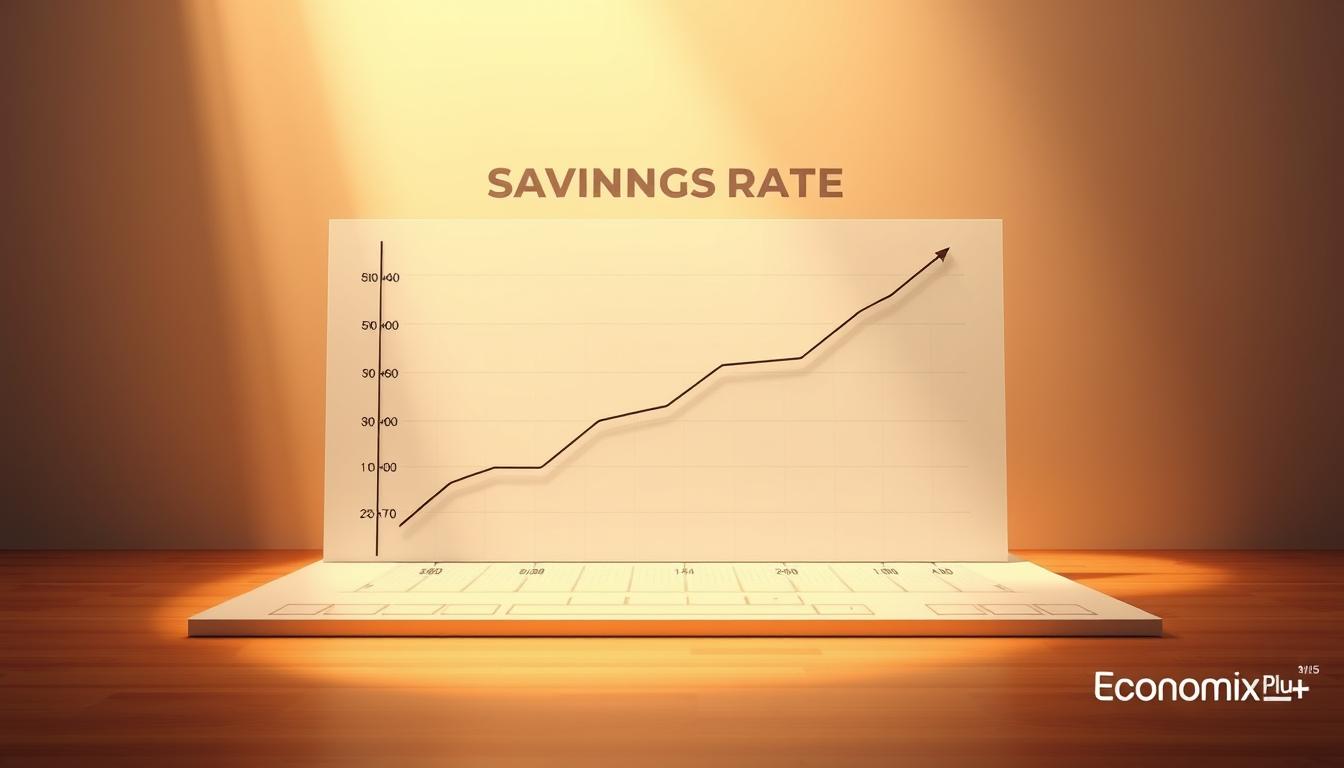Your savings rate is a crucial factor in achieving financial security, yet many Americans struggle to determine the right percentage of their income to save. Getting it right can make all the difference in achieving your financial goals, whether it’s retiring on time, buying a home, or building an emergency fund.
So, what’s the ideal savings rate for you? It depends on various factors, including your age, financial situation, and goals. A higher savings rate means more money saved each month, which can be a significant step towards securing your financial future.
Understanding your ideal savings rate is key to making progress towards your financial objectives, such as retirement or other savings goals. By the end of this guide, you’ll have a clear framework for determining your optimal savings rate and implementing sustainable saving habits.
Key Takeaways
- Learn how to calculate your current savings rate.
- Discover the ideal percentage of your income to save based on your age and financial situation.
- Explore practical strategies for increasing your savings rate without sacrificing your quality of life.
- Understand how to align your savings rate with your financial goals.
- Implement sustainable saving habits that work for you.
Understanding the Importance of Your Saving Rate
Your saving rate plays a significant role in determining your financial future. It’s a critical component of your financial plan that you have control over, unlike market returns or your lifespan. By focusing on your savings rate, you can make a significant impact on your long-term wealth.
To increase savings, it’s essential to consider the percentage of income you allocate towards saving for retirement. Let’s say you aim to increase your savings rate; this proactive approach can help many people achieve their financial goals more effectively.
Why Your Saving Rate Matters More Than Investment Returns
Your savings rate is the foundation of your financial future and has a more substantial impact on your long-term wealth than investment returns, especially in the early stages of your financial journey. While market performance fluctuates beyond your control, your savings rate is something you can actively manage and adjust within your household budget.
Research shows that individuals who maintain higher savings rates can effectively increase their savings rate and achieve their financial goals more reliably by understanding the amount of money they allocate to their savings account.
The Impact of Saving Rate on Your Financial Goals
Your savings rate directly impacts the timeline for achieving your financial goals, whether it’s retirement, homeownership, or financial independence. Understanding the mathematical relationship between your savings rate and financial goals helps create realistic expectations and timelines.
The compound effect of a consistently high savings rate over time creates a financial momentum that becomes increasingly powerful as your wealth grows.
| Savings Rate | Time to Reach Financial Goal | Impact on Wealth |
|---|---|---|
| Low ( | Longer | Limited |
| Moderate (10-20%) | Moderate | Noticeable |
| High (>20%) | Shorter | Significant |

By prioritizing your savings rate, you can take control of your financial future and make progress towards your goals. As Stephen R. Covey emphasizes in “The Seven Habits of Highly Effective People,” focusing on your circle of influence is key to achieving success.
How to Calculate Your Current Saving Rate
Calculating your current saving rate is a crucial step in understanding your financial health and planning for saving retirement. It gives you a clear picture of how much of your income you’re saving each month, which is essential for achieving your financial goals and increasing savings over the years.
By assessing your net savings amount, you can ensure that your household accounts are aligned with your retirement objectives.
The Basic Saving Rate Formula
To calculate your saving rate, you need to divide your total monthly savings by your monthly gross income, then multiply by 100 to convert to a percentage.
This simple formula provides a standardized measurement that allows for meaningful comparisons across different tax situations and income levels. For instance, if your monthly gross income is $5,000 and you save $1,000, your saving rate would be 20%.

Including All Types of Savings in Your Calculation
When calculating your saving rate, it’s essential to include all forms of savings, such as retirement accounts (including employer matches), emergency funds, and down payment savings. Using gross income rather than net income provides a more accurate picture of your savings.
Many people mistakenly exclude certain types of savings from their calculations, leading to an inaccurate understanding of their true savings rate.
- Include all forms of saving: retirement accounts, emergency funds, down payment savings, and other dedicated savings vehicles.
- Use gross income (pre-tax earnings) for a more standardized measurement.
- Regularly recalculate your savings rate to monitor progress and make necessary adjustments.
How to Determine the Ideal Saving Rate for Your Income?
Determining your ideal saving rate is crucial for achieving financial stability in your household. It’s not just about saving money; it’s about saving the right amount based on your income and financial goals to increase savings over the years. Understanding the percentage income that should be allocated can make a significant sense in planning for your future and save for retirement.
The 50-30-20 Rule: Is It Right for You?
The 50-30-20 rule is a widely recommended guideline that suggests allocating 50% of your income towards needs, 30% towards wants, and 20% towards savings.
This rule provides a balanced framework that works well for many income levels. However, it may not be suitable for everyone, especially those with higher essential expenses or living in high-cost areas.

The 80-20 Alternative Approach
For those who find the 50-30-20 rule too rigid or unrealistic, the 80-20 alternative approach offers a simpler solution. This method involves allocating 20% of your paycheck towards savings and the remaining 80% towards all expenses (both needs and wants combined). The idea is to maintain the 20% savings rate while allowing for flexibility in your spending.
Your ideal savings rate should be personalized based on your specific circumstances, including your current age, retirement goals, existing savings, debt obligations, and major upcoming life expenses.
While 20% is often cited as the ideal savings rate, this percentage may need to be higher if you’re starting to save later in life or have ambitious financial goals like early retirement.
When determining your ideal rate, consider your entire financial picture—including housing costs, debt repayment, and healthcare expenses—to ensure your savings plan is realistic and sustainable. The right savings rate balances current lifestyle needs with future financial security, allowing you to enjoy life today while still building toward your long-term goals.
Age-Based Saving Rate Recommendations
Understanding the right saving rate for your age is crucial for achieving financial security and a comfortable retirement. As you progress through different life stages, your financial priorities and income levels change, influencing the ideal savings rate for your situation.
To effectively save for retirement, it’s important to consider the amount you can set aside each month, and how increasing your savings rate over the years can significantly impact your household finances, especially when factoring in taxes and other obligations.
Saving Rates for Your 20s and 30s
In your 20s and early 30s, financial experts recommend saving 10-15% of your income each month. Starting early allows you to benefit from decades of compound growth, aiming to accumulate 1-1.5 times your annual salary by age 35.
This early start is crucial for building a substantial retirement fund and can help increase your savings rate over the years, positively impacting your net money and account balance.
Saving Rates for Your 40s and 50s
As you enter your 40s, your savings rate should ideally increase to 15-20%, with a goal of having 3-4 times your annual salary saved by age 45 and 5-6 times by age 50.
Let’s say by your 50s, if you’re behind on retirement savings, your savings rate may need to reach 20-25%, targeting 6-7 times your annual salary by age 55, especially when considering taxes and the need to increase your savings rate over the years to ensure a solid net money position.
Adjusting Your Saving Rate as You Approach Retirement
As you approach retirement in your late 50s and 60s, you should aim to have 8-10 times your annual salary saved. This may require savings rates of 25% or higher if you’re playing catch-up.
Adjust these recommendations based on your retirement timeline, expected lifestyle in retirement, and other sources of retirement income.
| Age Group | Recommended Savings Rate | Retirement Savings Goal |
|---|---|---|
| 20s-30s | 10-15% | 1-1.5 times salary by 35 |
| 40s | 15-20% | 3-4 times salary by 45 |
| 50s | 20-25% | 6-7 times salary by 55 |
| Late 50s-60s | 25% or higher | 8-10 times salary |

Tailoring Your Saving Rate to Your Financial Goals
Your financial goals play a crucial role in determining your ideal savings rate. Whether you’re saving for retirement, a home purchase, education costs, or building an emergency fund, your savings rate should be directly tied to your specific financial goals.

Short-Term vs. Long-Term Saving Goals
When it comes to saving, it’s essential to differentiate between short-term and long-term goals. Short-term goals, such as building an emergency fund or saving for a vacation, typically require more aggressive, focused saving for brief periods. In contrast, long-term goals like retirement benefit from consistent contributions over decades.
For instance, you may need to allocate a larger portion of your income towards a down payment on a home in the next few years, while dedicating a smaller percentage to retirement savings.
Balancing Multiple Financial Priorities
When balancing multiple financial priorities, consider allocating different percentages of your overall savings rate to each goal based on urgency, importance, and timeline. For example, you might allocate 15% of your income to retirement savings, 3% to a home down payment, and 2% to an emergency fund.
To get a personalized plan, you can visit https://beyondyourhammock.com/how-much-to-save/ to determine your recommended savings rate based on your age and financial goals. Regularly reassessing your goals and adjusting your savings allocations as priorities shift throughout different life stages is also crucial.
Strategies to Increase Your Saving Rate
To increase your savings rate, you need to focus on both reducing expenses and increasing income. By implementing these strategies, you can achieve a significant boost in your savings without necessarily changing your current lifestyle.
For instance, if you want to save for retirement, you might consider allocating a percentage of your income to your savings.
Let’s say you plan for the next few years; factoring in taxes and adjusting your budget can help you effectively increase your savings rate.
Reducing Expenses to Save More
Strategically reducing expenses is one of the most immediate ways to increase your savings rate. Start by analyzing your three largest spending categories, which typically offer the biggest opportunities for meaningful savings. Consider adjustments such as opting for a smaller home, finding a roommate, or relocating to a lower-cost area to reduce housing costs, which often represent the largest expense for most households.
- Housing costs can be minimized by considering a smaller home or a roommate.
- Transportation expenses can be significantly reduced by maintaining your current vehicle longer or using public transportation.
- Regularly review and negotiate recurring expenses like insurance and subscriptions to eliminate unnecessary costs.
Increasing Income to Boost Your Saving Rate
Making more money is a great way to save more without changing your lifestyle. You can increase your income through various means such as starting a side hustle, seeking a new position, or negotiating a raise. When your income increases, avoid lifestyle inflation by maintaining your current spending levels and directing the additional income toward savings.
- Starting a side hustle or seeking a new position can significantly boost your income.
- Consider dedicating a percentage of all raises and bonuses directly to savings.
- Avoid lifestyle inflation by directing additional income toward savings.
Implementing the “Pay Yourself First” Method
Adopting the “Pay Yourself First” strategy can revolutionize your approach to saving and help you increase your savings rate.
This method involves setting aside a percentage of your income for savings as soon as you receive your paycheck, treating savings as your most important monthly “bill.” Let’s say you ensure that your savings goals are prioritized over discretionary spending to save for retirement this year.

Automating Your Savings
Automation is key to successfully implementing the “Pay Yourself First” method. You can achieve this by setting up direct deposits from your paycheck to a dedicated savings account or by configuring automatic transfers through your bank to occur immediately after payday. This approach removes the temptation to spend and ensures consistent savings. Research shows that people who automate their savings save on average 3-5 times more than those who save manually.
- Set up direct deposit from your paycheck to your savings account.
- Configure automatic transfers through your bank.
Avoiding Lifestyle Inflation as Income Grows
As your income increases, it’s essential to avoid the trap of lifestyle inflation. Instead of spending more on luxuries, maintain your current lifestyle and direct the additional income towards your savings. This strategy will help you steadily increase your savings rate without feeling the pinch. By prioritizing savings, you’ll be better equipped to achieve your long-term financial goals.
To effectively avoid lifestyle inflation, consider the following:
- Maintain your current lifestyle despite income increases.
- Automatically direct additional income towards savings.
Common Obstacles to Maintaining Your Ideal Saving Rate
Maintaining an ideal savings rate is crucial for achieving financial stability and can help you increase savings rate over the years, but it’s often challenging due to various financial obstacles. The journey to your ideal savings rate is often fraught with financial difficulties that need to be addressed.
Understanding these challenges is the first step towards overcoming them and staying on track with your savings goals to save retirement for the coming years.
Dealing with Debt While Trying to Save
High-interest debt, such as credit card balances, can significantly hinder your ability to save retirement. To effectively manage debt while saving, let say you consider adopting a strategic approach that balances debt repayment with saving a percentage income, rather than focusing on one at the expense of the other. By doing so, you can make progress on both fronts and avoid the pitfalls of an all-or-nothing mentality.
Adjusting Your Saving Rate During Financial Hardship
During periods of financial hardship, such as job loss or medical emergencies, it may be necessary to temporarily adjust your savings rate for the year. Having a contingency plan in place can help you navigate these challenging times without completely abandoning your saving habits. This might involve reducing your savings rate or exploring alternative sources of income to supplement your finances.
Conclusion: Creating a Sustainable Saving Plan
A well-crafted savings plan is essential for balancing today’s needs with tomorrow’s financial security. Your monthly savings rate significantly influences whether you reach your financial goals. To create a sustainable plan, you must find a balance between your current lifestyle and future needs.
Regularly reviewing and adjusting your savings rate ensures it remains aligned with your changing circumstances and goals. Successful savers often start with modest rates and gradually increase them over time, particularly when income rises. By implementing these strategies, you can determine and maintain an ideal savings rate that balances present enjoyment with future security, putting you on the path to achieving your most important financial goals, including a secure retirement.
FAQ
▶
▶
▶
▶
▶
▶
▶














